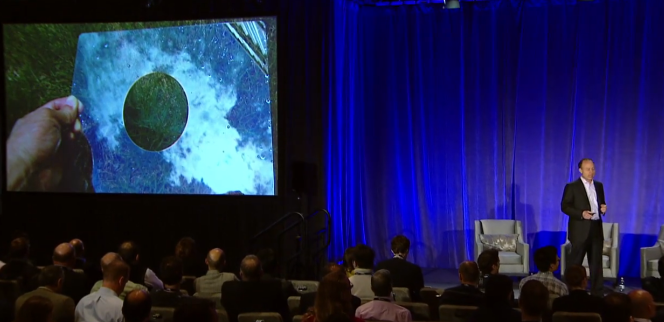From the Corning talk summary:
Evenson explained that glass is a lot stronger than most people think. And because it’s also stable, transparent, and impermeable, it will continue to be the perfect partner for mobile electronics in an ever-connected world. He offered a host of examples that illustrate how Corning’s precision glass can be vital to every facet of the mobile experience – “how you see information, how you touch information, how you transmit information, and even how that information gets processed.”
Here are a few examples of how he encouraged the conference audience to think of glass in a new way:
- Glass can withstand an astonishing amount of pressure. Imagine, for example, a scale that measures the pressure under an elephant’s foot. Glass can theoretically tolerate the pressure of 10,000 elephants stacked on top of that scale – a strength of 10 gigapascals.
- A sheet of glass is so stable that it would take 20 trillion times the age of the earth to create a visible sag in the thickness of a glass window. This dimensional stability is critical to manufacturers of high-performance devices.
- You want to talk transparency? The glass used for optical fiber – which forms the backbone of the Internet – is 30 times more transparent than the purest water, and only about 1 percent less transmissive of light than air on a clear day.
- As for being impermeable – consider the difference between plastic and glass covers on electronics. A molecule of oxygen could pass through a piece of 1-millimeter-thick plastic in about two weeks. That same trip would take 30 billion years through the same thickness of glass. That makes glass “an ideal enclosure for advanced display technologies such as OLEDs, which decay rapidly if exposed to oxygen or water,” Evenson said.
How does Corning do it? Evenson explained that Corning understands how formulation and fabrication determine the atomic state and structure of a glass. These, in turn, control the mechanical, thermal, and optical properties of the glass....
Evenson also teased the slide shown here, saying "You see this piece of glass with the hole in it? Actually, it's not a hole, that's the area where we've incorporated our new anti-reflective technology":

The effect looks somewhat similar to Nokia's ClearBlack Display polariser system, though it's not clear whether a similar optical arrangement has been used. You can view the entire (roughly 30 minutes) talk here.
Corning isn't the only company involved in making toughened glass, of course, but it does seem to be the leader, certainly in terms of vision - you may remember the “A Day Made of Glass” video from last year and its followup, with commentary (and embedded below)? Very cool and, surprisingly, more and more believable as time goes on - it's amazing how fast processor and GPU speeds are rising, how intelligent our embedded devices are becoming:
